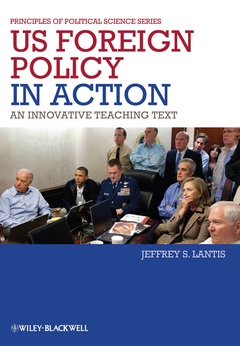Description
US Foreign Policy in Action
An Innovative Teaching Text
Principles of Political Science Series
Author: Lantis Jeffrey S.
Language: English
Subject for US Foreign Policy in Action:
Approximative price 89.78 €
In Print (Delivery period: 12 days).
Add to cartPublication date: 01-2013
356 p. · 17.8x25.4 cm · Hardback
Publication date: 01-2013
356 p. · 16.8x24.1 cm · Paperback
Description
/li>Contents
/li>Biography
/li>
This innovative teaching text on United States foreign policy interprets the foreign policy decision-making process through the lens of political debate and exchange. It introduces historical developments and theories of U.S. foreign policy and engages students in the politics of the foreign policy process through innovative learning exercises.
- Features critical analysis of contemporary trends in U.S. foreign policy, including debates in the Obama administration, foreign policy and the 2012 presidential election, and reaction to the Arab Spring
- Written by an award-winning teacher-scholar in international relations, with extensive experience in both policy making and pedagogy
- Views foreign policy decision making through the lends of political debate
- Offers fresh perspectives on historical developments as well as surveying prominent foreign policy theories
- Includes new and innovative participatory learning exercises exploring a range of themes including executive/ legislature conflict
- Contains extensive teaching and learning applications, including discussion questions, document templates, worksheets, suggested readings, and links to web resources throughout
List of Photos ix
List of Figures xi
List of Maps xii
List of Tables xiii
Preface and Acknowledgments xiv
1 Introduction: United States Foreign Policy in Action 1
Historical Foundations 3
Major Actors in the Foreign Policy Process 7
Pedagogical Approach: How to Use This Book 9
Key Features 10
Overview of the Book 11
2 The History of US Foreign Policy 14
Revolutionary Values 15
The Struggle to Defi ne the New Nation 18
Manifest Destiny? 22
The Civil War 24
Rise to Globalism 26
The “American Century” and World Wars 29
Discussion Questions 35
3 Foreign Policy in the Cold War and Post-Cold War Era 38
Introduction 39
The Cold War 40
The Truman Doctrine 42
Korea and Vietnam 45
Redefining Values and Interests? 47
The End of the Cold War 55
Engagement and Enlargement 58
Interests versus Values? The War on Terrorism 59
Discussion Questions 64
4 Key Government Institutions: The President, Congress, and the Courts 68
Section I: Constitutional Authority and the “Invitation to Struggle” 69
The President and the Executive Branch 71
Presidential Influence 72
Instruments of Presidential Power 83
Congress: The Legislative Branch 84
The Courts: The Judicial Branch 95
Conclusion 98
Discussion Questions 99
Section II: Structured Debate: Leadership in Action and the War on Terrorism 100
Guidelines and Rules of Procedure 100
Debate: Executive Dominance and the War on Terrorism 101
Background: The War on Terrorism 101
Framing the Debate: Values and Interests 103
Position 1: YES, The President Should Have Greater Authority in the War on Terrorism 103
Additional Resources 105
Position 2: NO, The President Should Not Have More Foreign Policy Authority 106
Additional Resources 111
5 Bureaucracies: Unelected Actors in the Foreign Policy Process 116
Section I: Bureaucracies and Foreign Policy 117
Key Characteristics of Bureaucracies 117
The Theory of Bureaucratic Politics 119
The Department of Defense 122
The Department of State 129
Intelligence Bureaucracies 137
Discussion Questions 144
Section II: National Security Council Simulation: Bureaucratic Politics in Action 145
Exercise Scenario: Proliferation Threats 147
Iranian Nuclear Ambitions 148
Appendices: Templates and Role Assignments 155
Additional Resources 160
6 Interest Groups and Political Parties 163
Section I: The Power of Unelected Actors 164
Interest Groups 164
What Do You Want? How to Lobby Effectively 168
Types of Interest Groups 171
Political Parties 179
Conclusion: Are All Politics “Local”? 185
Discussion Questions 185
Section II: Interest Groups in Action: Case-Based Learning 186
Pedagogical Approach 186
Environmental Policy: The United States, Interest Groups, and Climate Change 186
A Change of Climate? 193
Legislative Showdown 197
Case Discussion Questions 200
7 Public Opinion and the Media 204
Section I: Reaching the Masses? Public Opinion and the Media 205
Public Opinion 205
Public Attitudes and Foreign Policy: A Direct Line? 214
Media and Foreign Policy 216
The Functions of Media 217
Contemporary Trends in Media Coverage 221
Discussion Questions 224
Section II: Public Opinion and the Media in Action: Problem-Based Cooperative Learning 226
Research Project 1: Alternative News Media and Foreign Policy: Educating the Public? 226
Research Project 2: The Media and National Security: Is There a Public “Right to Know”? 230
8 Grand Strategy: Then and Now 243
Section I: What is Grand Strategy? 244
Alternative Grand Strategy Frames for US Foreign Policy Positions 246
Hegemony/Unilateralism 247
Multilateralism 251
Isolationism/Parochialism 255
Formulating Grand Strategy in the Post-9/11 World 258
Discussion Questions 260
Section II: Structured Debate: A New Grand Strategy for the Twenty-First Century? 262
Guidelines and Rules of Procedure 262
Framing the Debate 263
Position 1: YES, A New Foreign Policy Should be Strongly Multilateral – Vital Interests are Global 263
What Does Multilateralism Mean for Foreign Policy? 265
Transnational Issues and Multilateral Solutions 265
Additional Resources 270
Position 2: NO, A New Foreign Policy Should be Isolationist/Parochial – Vital Interests are Domestic 270
“It’s the Economy, Stupid” 271
What Does Parochialism Mean for US Foreign Policy? 272
The War on Terror and US Parochialism 274
A Sustainable Foreign Policy Agenda? 276
Additional Resources 278
9 Contemporary Foreign Policy Analysis 282
Fundamental Dynamics of Foreign Policy 283
Obama Foreign Policy 285
The Arab Spring Meets Liberal Engagement 288
Domestic Political Constraints 289
Foreign Policy Continuity versus Change 293
What Can You Do? 295
Bibliography 298
Index 324




